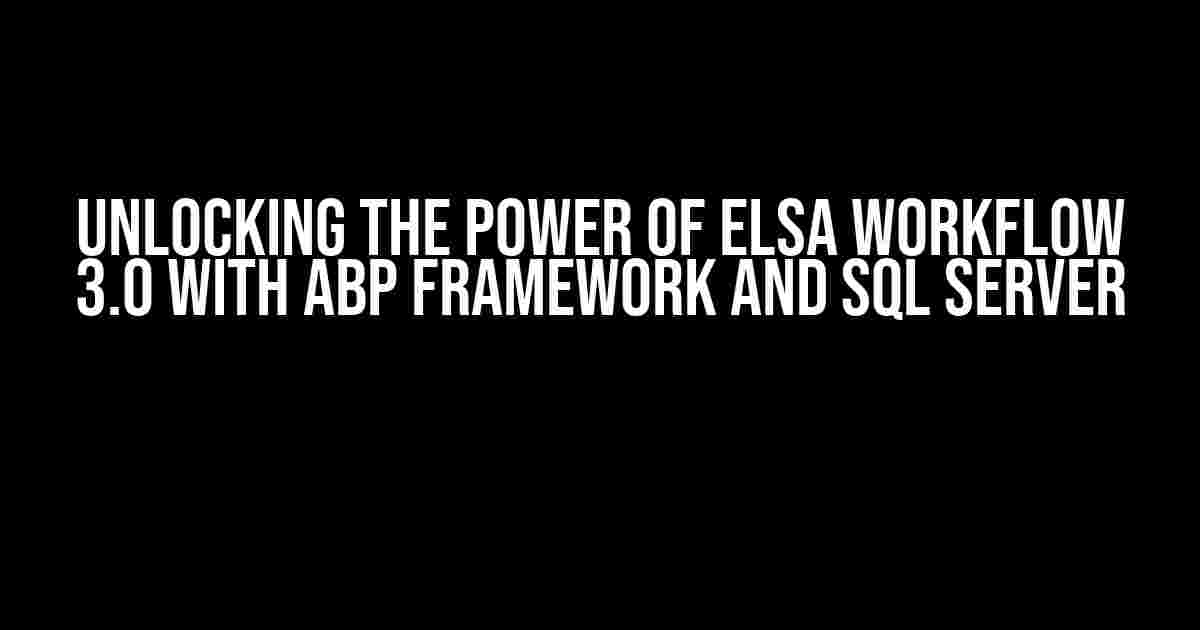Are you ready to take your workflow automation to the next level? Look no further! In this article, we’ll guide you through the process of integrating Elsa Workflow 3.0 with the ABP Framework and SQL Server. Get ready to streamline your business processes and boost efficiency like never before!
What is Elsa Workflow 3.0?
Elsa Workflow 3.0 is a powerful, open-source workflow engine that enables you to design, execute, and monitor business processes with ease. With its user-friendly interface and robust features, Elsa Workflow 3.0 is the perfect solution for automating complex workflows and integrating with various systems.
What is ABP Framework?
The ABP Framework is a popular, open-source framework for building modern web applications. It provides a modular, scalable, and maintainable architecture that simplifies the development process. With its strong focus on best practices and code quality, the ABP Framework is an ideal choice for building robust and efficient applications.
What is SQL Server?
SQL Server is a powerful, enterprise-level relational database management system (RDBMS) that enables you to store, manage, and analyze large amounts of data. With its robust features, scalability, and security, SQL Server is a popular choice for businesses of all sizes.
Why Integrate Elsa Workflow 3.0 with ABP Framework and SQL Server?
Integrating Elsa Workflow 3.0 with the ABP Framework and SQL Server offers numerous benefits, including:
- Streamlined business processes: Automate complex workflows and integrate with various systems to boost efficiency and reduce manual errors.
- Improved scalability: Take advantage of the ABP Framework’s modular architecture and SQL Server’s robust scalability to handle large volumes of data and traffic.
- Enhanced security: Leverage SQL Server’s enterprise-level security features to protect sensitive data and ensure compliance with regulatory requirements.
- Faster development: Use the ABP Framework’s pre-built features and Elsa Workflow 3.0’s visual interface to accelerate development and reduce time-to-market.
Step-by-Step Guide to Integrating Elsa Workflow 3.0 with ABP Framework and SQL Server
Now that we’ve covered the basics, let’s dive into the step-by-step guide to integrating Elsa Workflow 3.0 with the ABP Framework and SQL Server.
Step 1: Install Elsa Workflow 3.0
First, you’ll need to install Elsa Workflow 3.0. You can do this by running the following command in your terminal:
dotnet new elsa-workflowStep 2: Create a New ABP Framework Project
Next, create a new ABP Framework project using the following command:
abp new MyWorkflowAppStep 3: Install Required NuGet Packages
In your ABP Framework project, install the required NuGet packages using the following commands:
dotnet add package Elsa.Workflow
dotnet add package Elsa.Persistence.EntityFrameworkCore
dotnet add package Microsoft.EntityFrameworkCore.SqlServerStep 4: Configure Elsa Workflow 3.0
In your ABP Framework project, create a new class called `ElsaWorkflowConfig` and add the following code:
using Elsa.Workflow;
using Elsa.Persistence.EntityFrameworkCore;
using Microsoft.EntityFrameworkCore;
public class ElsaWorkflowConfig
{
public void ConfigureWorkflow(IServiceCollection services)
{
services.AddElsa(elsa =>
{
elsa.UseEntityFrameworkCorePersistence(options =>
{
options.UseSqlServer("Server=tcp:localhost,1433;Database=mydatabase;User ID=myusername;Password=mypassword;");
});
});
}
}Step 5: Initialize Elsa Workflow 3.0
In your ABP Framework project, create a new class called `ElsaWorkflowInitializer` and add the following code:
using Elsa.Workflow;
using Microsoft.Extensions.DependencyInjection;
public class ElsaWorkflowInitializer
{
public void Initialize(IServiceProvider serviceProvider)
{
var workflowRuntime = serviceProvider.GetService<IWorkflowRuntime>();
workflowRuntime.Initialize();
}
}Step 6: Create a New Workflow
Using the Elsa Workflow 3.0 visual interface, create a new workflow by following these steps:
- Open the Elsa Workflow 3.0 dashboard and click on the “New Workflow” button.
- Enter a name and description for your workflow, and click “Create.”
- Drag and drop activities onto the canvas to design your workflow.
- Configure each activity by clicking on it and setting the required properties.
- Save and publish your workflow.
Step 7: Integrate the Workflow with ABP Framework
In your ABP Framework project, create a new class called `MyWorkflowService` and add the following code:
using Elsa.Workflow;
using Microsoft.Extensions.DependencyInjection;
public class MyWorkflowService
{
private readonly IWorkflowRuntime _workflowRuntime;
public MyWorkflowService(IServiceProvider serviceProvider)
{
_workflowRuntime = serviceProvider.GetService<IWorkflowRuntime>();
}
public void StartWorkflow()
{
var workflowInstance = _workflowRuntime.StartWorkflow("MyWorkflow");
// Perform additional logic or processing as needed
}
}Step 8: Test the Workflow
Finally, test your workflow by calling the `StartWorkflow` method in your `MyWorkflowService` class. Verify that the workflow is executed correctly and that the desired outcome is achieved.
Conclusion
Integrating Elsa Workflow 3.0 with the ABP Framework and SQL Server is a powerful combination that enables you to automate complex business processes, improve scalability, and enhance security. By following the step-by-step guide in this article, you can unlock the full potential of these technologies and take your workflow automation to the next level.
| Technology | Benefits |
|---|---|
| Elsa Workflow 3.0 | Streamlined business processes, improved efficiency, and reduced manual errors |
| ABP Framework | Modular architecture, scalability, and maintainability |
| SQL Server | Robust scalability, security, and data management |
Remember to explore the official documentation and resources for Elsa Workflow 3.0, ABP Framework, and SQL Server to learn more about their features and capabilities.
Get started today and take the first step towards automating your business processes with Elsa Workflow 3.0, ABP Framework, and SQL Server!
Here is the HTML code for 5 Questions and Answers about “Using Elsa Workflow 3.0 with ABP Framework and use sqlserver”:
Frequently Asked Question
Get answers to the most commonly asked questions about using Elsa Workflow 3.0 with ABP Framework and SQL Server.
What are the benefits of using Elsa Workflow 3.0 with ABP Framework and SQL Server?
By combining Elsa Workflow 3.0 with ABP Framework and SQL Server, you can create a robust and scalable workflow system that integrates seamlessly with your existing applications. This trifecta of technologies offers improved workflow automation, enhanced data management, and superior performance.
How do I integrate Elsa Workflow 3.0 with ABP Framework?
To integrate Elsa Workflow 3.0 with ABP Framework, you’ll need to install the Elsa.Workflow.Abp package and configure the workflow module in your ABP project. This involves adding the necessary dependencies, setting up the workflow database, and defining your workflows using Elsa’s visual workflow designer.
What are the advantages of using SQL Server with Elsa Workflow 3.0 and ABP Framework?
SQL Server provides a robust and scalable database solution for your workflow data. With SQL Server, you can benefit from high-performance data storage, transactional consistency, and advanced security features. Additionally, SQL Server’s support for stored procedures and SQL CLR integration enables you to create custom database logic and extend your workflow functionality.
Can I use Elsa Workflow 3.0 with ABP Framework and SQL Server for complex workflow scenarios?
Yes, Elsa Workflow 3.0 is designed to handle complex workflow scenarios. With its advanced workflow engine and visual workflow designer, you can model and execute complex workflows that involve multiple tasks, conditions, and rules. The combination of Elsa Workflow 3.0, ABP Framework, and SQL Server provides a robust and scalable solution for even the most intricate workflow requirements.
What kind of support is available for Elsa Workflow 3.0 with ABP Framework and SQL Server?
You can find extensive documentation, tutorials, and community support for Elsa Workflow 3.0, ABP Framework, and SQL Server. Additionally, the Elsa and ABP communities offer dedicated forums, GitHub repositories, and issue trackers to help you resolve any issues or ask questions. You can also consider professional support and consulting services for custom implementation and optimization.


